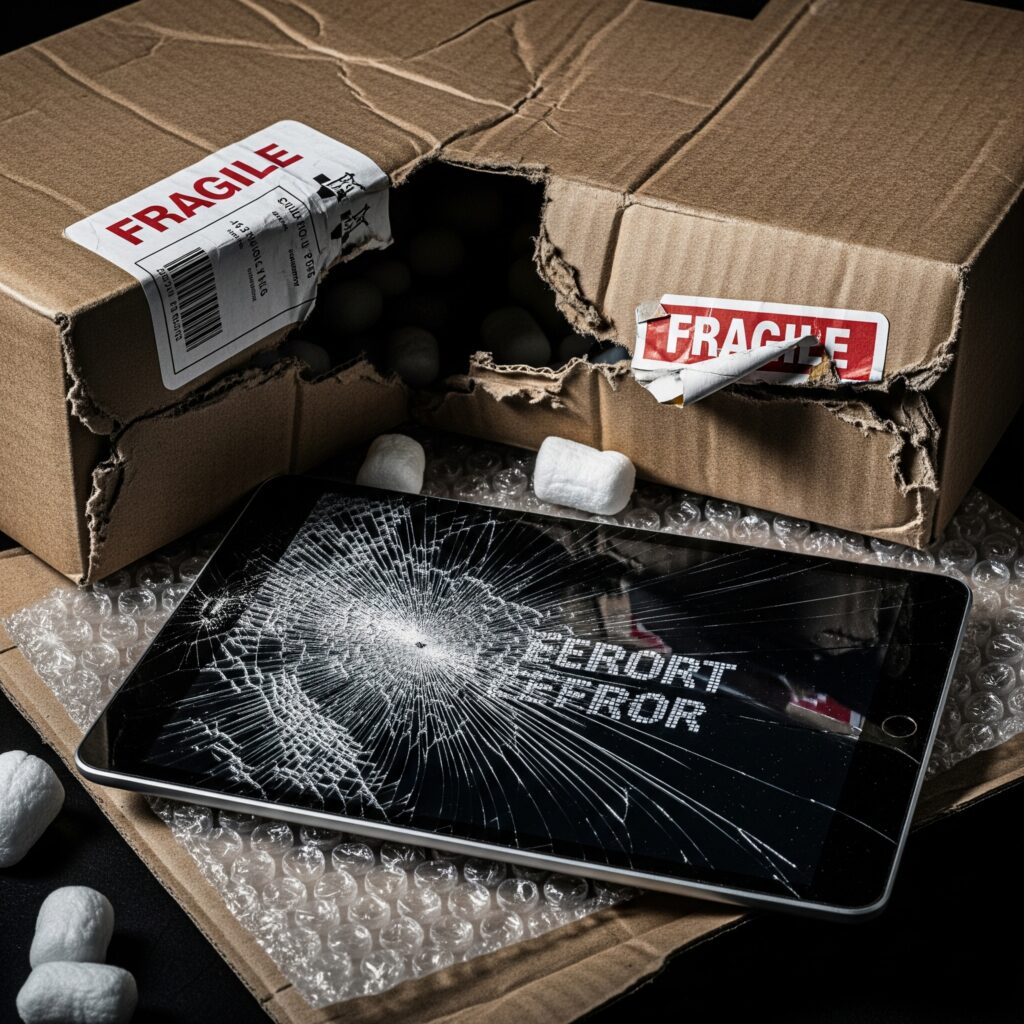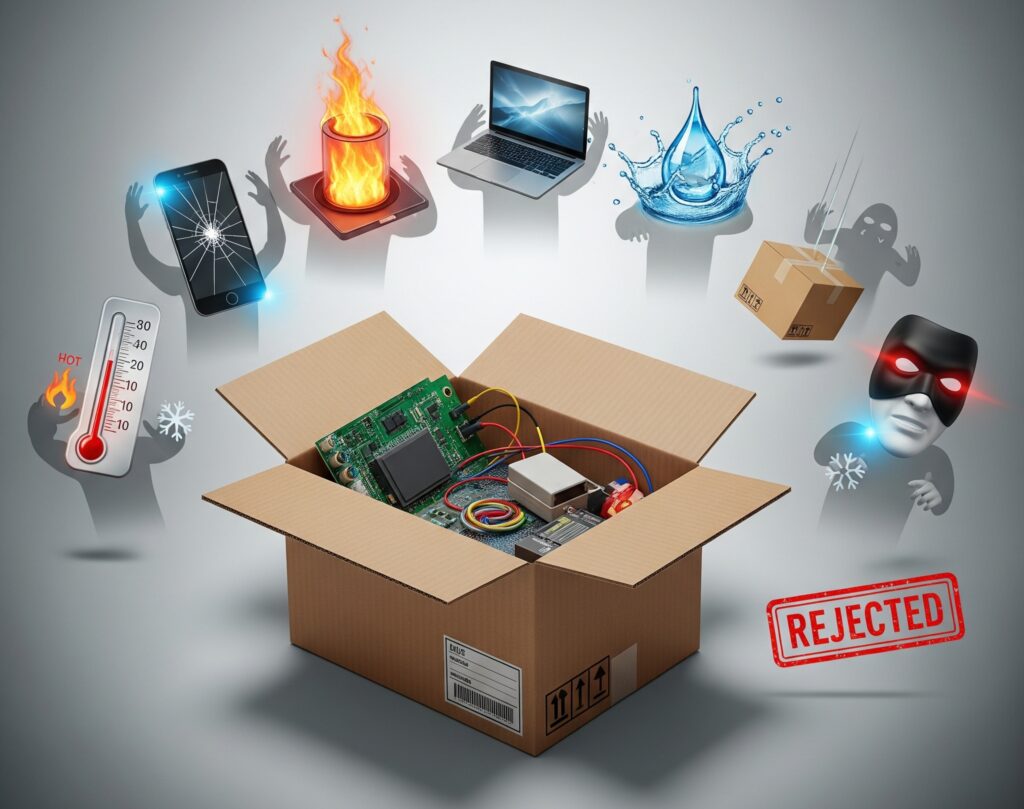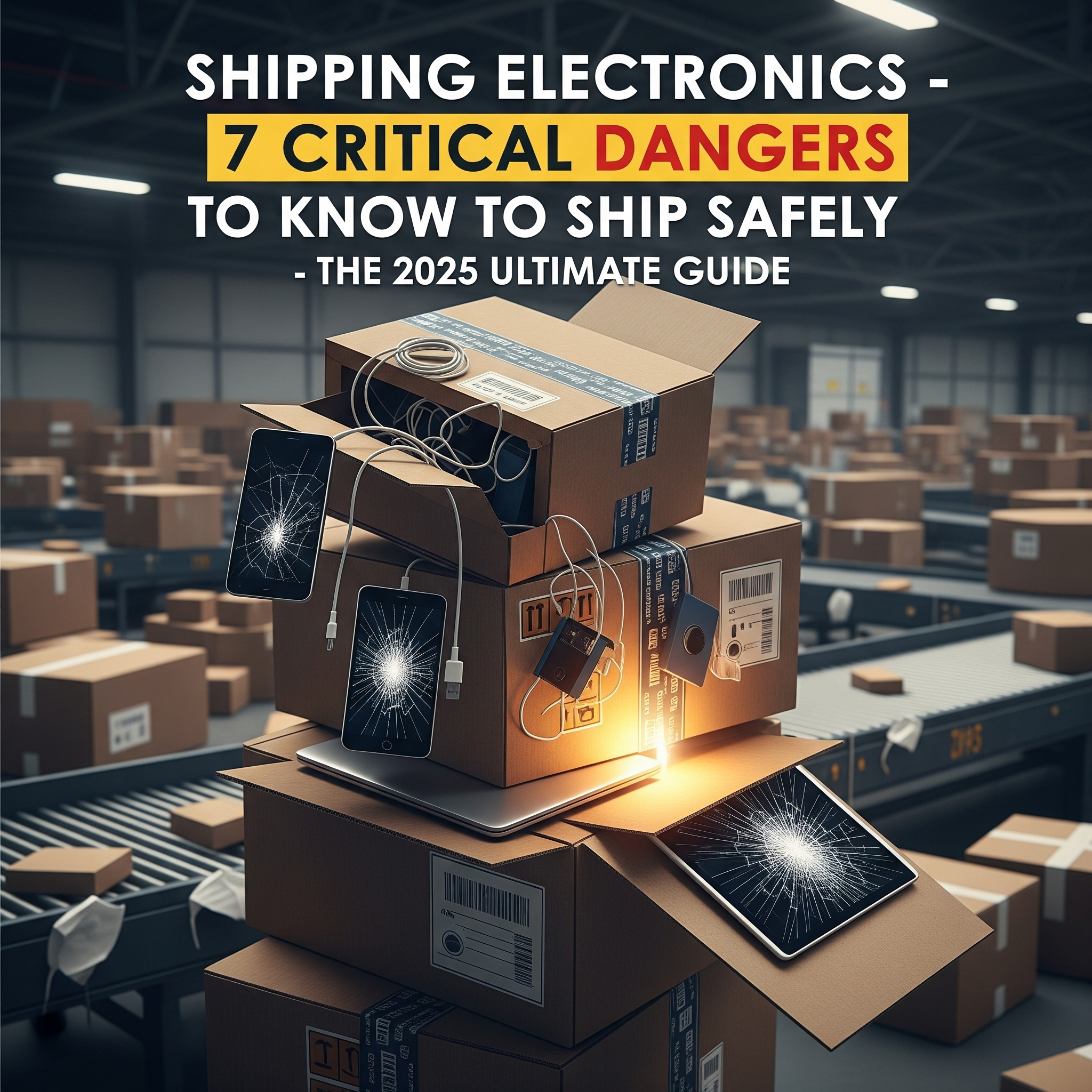Protect Yourself From the Risks of Shipping Electronics
In our hyper-connected digital age, the practice of shipping electronics has become the lifeblood of commerce, communication, and personal life. Every single day, millions of laptops, smartphones, servers, and sensitive components are packed into boxes for transit. Whether you’re an IT manager responsible for shipping electronics to a remote workforce, an e-commerce entrepreneur fulfilling orders, or an individual mailing a high-end device, the goal is always the same: a safe, secure, and successful delivery. The logistics behind shipping electronics are more complex than many realize.
You’ve likely invested significant time and money into the device itself, and perhaps even into sourcing the perfect sturdy box and ample bubble wrap. But have you truly considered the financial risks involved in shipping electronics? Assuming a “FRAGILE” sticker is a magical forcefield is the first step toward a potentially catastrophic financial loss.
This guide is your essential, behind-the-scenes look at the modern realities of shipping electronics. We will pull back the curtain on the hidden journey of your package, dissect the seven critical dangers that can damage your valuable tech, and, most importantly, debunk the single most dangerous myth about carrier “coverage.” By the end, you will understand not just how to pack a box, but how to truly protect your investment when shipping electronics.

The Secret Life of a Shipped Package: The Perilous Journey of Shipping Electronics
To truly grasp the risks involved in shipping electronics, you must first understand the journey. Far from a gentle, hand-delivered process, modern logistics is a marvel of automated, high-speed efficiency built for volume. Your package is just one among millions, and it will be subjected to forces and environments you would never willingly expose your devices to. The process of shipping electronics is not as simple as moving a box from A to B.
Stage 1: The First Mile – The Initial Risks in Shipping Electronics
The journey begins the moment the package is out of your sight. Whether you drop it at a retail shipping store or have a driver pick it up, it’s immediately introduced into a system of constant movement. It will be stacked in a truck with hundreds of other packages. A heavy box of books could be casually placed on your lightweight laptop box, causing unseen pressure. The driver, rushing to meet tight deadlines, may toss it more forcefully than you’d like. This initial stage of shipping electronics introduces the first risks of impact and compression.
Stage 2: The Belly of the Beast – The Regional Sorting Hub
This is where the true chaos of shipping electronics begins. Your package arrives at a massive regional sorting facility, a sprawling warehouse filled with a dizzying network of conveyor belts, chutes, and automated sorting machines designed to process tens of thousands of packages per hour.
- High-Speed Conveyors: Your package will travel at high speeds, navigating sharp turns and steep inclines.
- Automated Scanners & Diverters: Powerful mechanical arms will divert your package onto different tracks based on its barcode, often with significant force. This is a major point of risk when shipping electronics.
- The “Waterfall”: In many facilities, packages are sent down large slides or chutes. Your box will tumble and collide with dozens of others, regardless of the “FRAGILE” sticker.
- The Final Sort: It’s then sorted into a large bin or container. Here, the risk of crushing is at its peak, as your box could end up at the bottom of a pile weighing hundreds of pounds.
The environment is loud, fast, and entirely indifferent. This stage is where a significant amount of damage occurs during the process of shipping electronics.
Stage 3: The Long Haul – Transport Risks by Air and Ground
Once sorted, your package is loaded onto a long-haul vehicle. The mode of transport used for shipping electronics introduces its own unique set of environmental and physical risks.
- If by Air: The cargo hold of an airplane is not climate-controlled. As the plane ascends, temperatures can plummet to near freezing, which is a significant danger when shipping electronics with batteries. Air pressure changes can also stress seals and casings.
- If by Ground: A cross-country journey in a semi-trailer is a marathon of vibration. For days, your package will be subjected to constant, jarring shocks. This pervasive vibration is a silent killer, capable of shaking components loose. The temperature inside a trailer also poses a significant threat to safe shipping electronics.
Stage 4: The Final Mile – From Local Hub to Doorstep
The journey is almost over, but the final mile of shipping electronics presents its own dangers. This is where the risk of theft skyrockets. Delivery drivers on tight schedules may leave packages on doorsteps, in full view of opportunistic “porch pirates.” Even well-intentioned drivers can cause damage, rushing to drop off packages and move on.
A Taxonomy of Transit Dangers: The 7 Silent Killers When Shipping Electronics
Now that you understand the journey, let’s dissect the specific dangers your devices face. These are the “silent killers” that can turn a pristine device into a paperweight, often without leaving a single mark on the box. Any guide to shipping electronics must cover these critical points.

1. Kinetic Shock (Impact Damage)
This is the most obvious danger in shipping electronics. A dropped box is the classic example, but the reality is more nuanced. A short drop can generate immense G-forces, causing:
- Cracked screens on laptops, tablets, and phones.
- Dented casings and bent frames.
- Internal damage, such as a cracked motherboard or a dislodged hard drive head.
- Broken solder joints connecting critical chips to the circuit board.
2. Pervasive Vibration
This is the most underestimated risk when shipping electronics. Every mile on the road, your package is being subjected to a continuous stream of low-frequency vibrations. The cumulative effect is insidious:
- Component “Fretting”: Vibration can cause microscopic movement between connectors, leading to intermittent faults.
- Loosened Hardware: Screws holding components in place can slowly vibrate loose, leading to overheating or physical damage.
- Solder Joint Fatigue: Constant vibration can create micro-fractures in solder joints that grow over time, causing an open circuit. This type of damage is a major concern for anyone shipping electronics.
3. Extreme Temperatures
Electronics are designed to operate within a specific temperature range. The environments they encounter during shipping often fall far outside these safe limits.
- Cold: Lithium-ion batteries are particularly vulnerable to cold, which can permanently reduce their ability to hold a charge. This is a key consideration for shipping electronics in winter.
- Heat: Excessive heat can warp plastic casings, degrade adhesives, and dramatically shorten the lifespan of processors and other components.
4. Humidity and Moisture
Water is the arch-nemesis of all electronics. A package left on a loading dock during a rainstorm is an obvious problem, but a more subtle threat is condensation. When a package moves from a cold to a warm, humid environment, moisture can condense on the circuit boards inside the device, causing short circuits and corrosion. This is a serious risk factor in the process of shipping electronics.
5. Electrostatic Discharge (ESD)
ESD is the invisible assassin. An unseen spark, generated by the friction of packaging materials, can instantly destroy microscopic transistors and pathways inside an integrated circuit. It is a major cause of “dead on arrival” failures that are impossible to attribute to mishandling, making the safe shipping electronics a technical challenge.
6. Theft and “Porch Piracy”
Electronics are a high-value, easy-to-sell commodity, making them a prime target for thieves.
- Internal Theft: Organized theft rings can operate within logistics companies to target and steal high-value goods.
- Porch Piracy: This has become an epidemic. A branded box left on a doorstep is an open invitation for thieves. The risk of theft is one of the primary reasons to be cautious when shipping electronics.
7. The Crushing Weight of Reality
Your package will inevitably be stacked. In sorting hubs and on trucks, efficiency dictates that space is maximized. If your 10-pound box ends up at the bottom of a stack of 200 pounds of other goods, the resulting compression can easily deform the box and transfer that force directly to the device inside.
The Great Misconception: Why Carrier Liability Fails for Shipping Electronics
After reading about this gauntlet of risks, you might think the carrier is responsible. This is the most dangerous and costly assumption in the shipping electronics industry. The simple, unequivocal answer is NO.
What carriers provide is not insurance. It is a limited form of legal liability, and its primary purpose is to protect the carrier, not you. Relying on it is a financial gamble.
A Legal Limit, Not a Protective Service
Carrier liability is a pre-defined limit on their financial responsibility, almost always based on the package’s weight, not its value. The industry standard is a paltry $2.00 per pound. Your state-of-the-art, lightweight laptop is valued the same as a few pounds of gravel. This is the harsh reality you face when shipping electronics without proper protection.

The Staggering Financial Gap: A Detailed Breakdown
Let’s illustrate the financial exposure you face when shipping electronics with only carrier liability.
| Electronic Item | Typical Value | Approx. Weight | Carrier Liability Payout ($2/lb) | Your Out-of-Pocket Loss |
| Flagship Smartphone | $1,500 | 1 lb | $2.00 | $1,498.00 |
| Business Laptop | $2,500 | 4 lbs | $8.00 | $2,492.00 |
| Gaming Console (PS5/Xbox) | $700 | 8 lbs | $16.00 | $684.00 |
| Professional DSLR Camera | $4,000 | 3 lbs | $6.00 | $3,994.00 |
| Enterprise-Grade Server | $8,000 | 15 lbs | $30.00 | $7,970.00 |
| Medical Monitoring Device | $15,000 | 10 lbs | $20.00 | $14,980.00 |
The gap is a chasm. Relying on carrier liability is effectively self-insuring for 99% of the item’s value, a losing proposition for anyone shipping electronics of any significant value.
The “Declared Value” Trap in Shipping Electronics
“But wait,” you might say, “the carrier let me ‘declare a value’ for an extra fee!” This is another area of great confusion when shipping electronics. Declaring a higher value with a carrier is not the same as buying insurance.
You are simply paying a fee to increase the carrier’s maximum limit of liability. However, it does not change the fundamental terms. You still bear the enormous burden of proving the damage was the direct result of the carrier’s negligence. How can you prove unseen vibration caused a solder joint to fail? How can you prove ESD damage occurred in their facility? You can’t. In these common scenarios, even with a declared value, your claim will likely be denied.
Conclusion: The Proactive Approach to Shipping Electronics
The message should now be crystal clear: the journey of shipping electronics is fraught with risk, and the default coverage offered by carriers is woefully inadequate, leaving you exposed to catastrophic financial loss. Understanding these realities is the crucial first step. You must proactively move beyond what carriers offer and seek out a solution designed to protect your financial interest, not theirs. Proper planning is essential for safe shipping electronics.
This solution is true shipping insurance, often called “All-Risk” coverage. It is a dedicated financial product that closes the perilous gap left by carrier liability and provides a robust safety net. In our next guide, we will explore the different types of shipping insurance available, compare them head-to-head, and equip you with the right questions to ask to ensure you choose the best possible protection for your valuable tech.
Want to learn more about shipping insurance to protect your electronics? Contact us today or Sign Up for your free account!
Additional Resources
- Learn More About Shipping Insurance for Electronics
- Explaining Electrostatic Discharge (ESD)
- Packaging Standards and Best Practices
- Understanding Vibration Damage in Transit
- Regulations for Shipping Lithium Batteries (found in most electronics)
- General Supply Chain and Logistics Insights
- The Problem of Package Theft (“Porch Piracy”)





